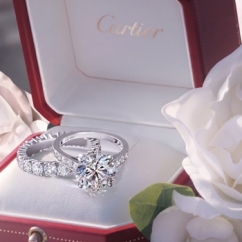Articles and News
CARTIER “GOSSIPS” FOR POSITIONING TO BOTH ULTRA- AND RISING AFFLUENTS | February 16, 2012 (1 comment)

New York, NY—A hit show can do wonders for products seen on the series. Take Sex & The City and what it did for the Fendi baguette bag and Manolo Blahnik shoes: it put Manolo on the map and launched Fendi’s baguette into a phenomenon, almost single-handedly launching the concept of the “It Bag.” And while Sarah Jessica Parker’s character Carrie Bradshaw favored Manolo Blahniks in particular, it elevated the entire designer shoe category, making luxury cobblers like Christian Louboutin and Jimmy Choo household names as well.
Now Cartier is hoping that integration of its brand into an episode of the CW’s Gossip Girl will do the same, according to this article from Luxury Daily. One of the first scenes of this week’s Monday night episode featured a supposed private home shopping experience with one of the brand’s salespeople, where one of the main characters was to select a Valentine’s gift for his wife from among a stack of red Cartier boxes set out on the table. Earlier in the season, the program featured a placement of Tiffany jewelry, and other luxury brands such as Chanel, Henri Bendel, and Gilt Groupe have made appearances on the show. Though the program, centered around the lives of privileged Manhattan prepsters, targets a younger audience than the typically older affluent customer sought by Cartier, placement helps build brand awareness among up-and-coming affluents and aspirational consumers, says the article.
Celebrity, TV, and movie placement is hugely important for a brand, says fashion expert Michael O’Connor. Speaking with The Centurion about a variety of topics this week, he illustrated some examples of not just trends, but real paradigm shifts that were driven by movies. The 1980s hit Flashdance sparked a fad for ripped sweatshirts and legwarmers, but long term, it made wearing gym clothes in public acceptable, says O’Connor. Likewise, the 1970s’ Annie Hall made fedoras and loose menswear appropriate for women, a look that’s come and gone periodically ever since.
Jewelers can work the celebrity angle in their own markets, says O’Connor. Designers can tie into celebrity placement programs sponsored by industry associations, while independent jewelers can seek out local TV and radio personalities, DJ’s, sports figures, or other celebrities. Ft. Lauderdale, FL-based Levinson Jewelers is a great example of a jeweler successfully tying into local celebrities, he says.
“They do outreach to these people to create partnerships and opportunities for exposure and excitement,” he says. “Whenever I’m down here I can’t open the newspaper without seeing something else Levinson is doing.”
Every jeweler should be reaching out to the local newspaper and TV lifestyle editor, and if possible, to socialites and celebrities in the area to dress them for events, suggests O’Connor. “But don’t just put your fate in someone else’s hands. Once you dress them, follow up with a call to the lifestyle editor that so-and-so was wearing such-and-such. Even if they’re willing to give your brand a plug, chances are they don’t know all the details of the piece so be sure to send a release with that information to the lifestyle editor.”







